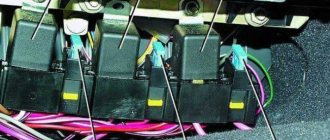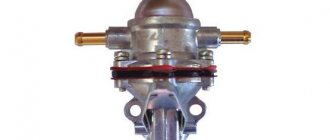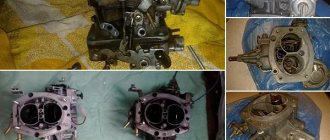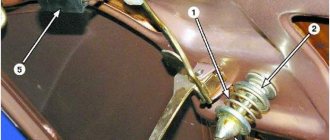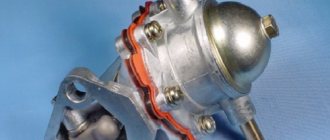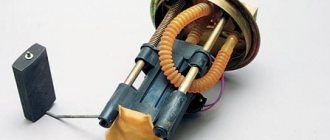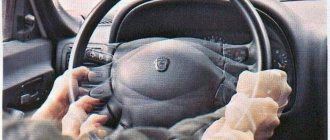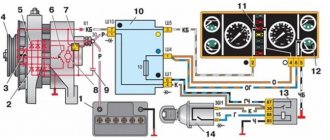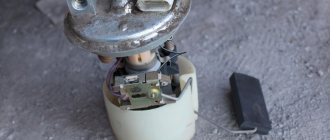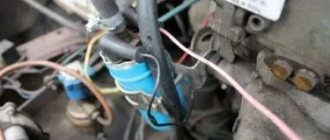In every car, the gas pump is considered one of the important devices that pumps fuel from the tank to the engine. The main thing is that it functions smoothly for good engine performance.
When checking the pump, it is necessary to determine the pressure. As a rule, the pressure of a submersible electric fuel pump is 2-4.5 bar (depending on the brand of the machine). Some engines reach 6 bar. Checking the pressure is not difficult, you just need to connect the pressure gauge to the car. The pump is also checked for productivity and the amount of current consumed.
Signs of a faulty fuel pump
The very fact of a malfunction or failure of the fuel pump is determined by a number of external signs. As a rule, this is the inability to start the car or interruptions in engine operation while driving. In addition, symptoms of a breakdown may include an uncharacteristic hum and loss of power during acceleration.
The fuel system of a modern car consists of the following elements:
fuel inlet pipe;
fuel outlet pipe;
The reason for stopping the fuel supply to the engine may be a malfunction of any of these components.
Symptoms of malfunction
If the fuel pump is completely faulty, the car will not be able to start. When such a breakdown occurs while driving, the engine will stall and the car will stop. If a technical problem is just beginning to appear, then at this stage you can judge the malfunction of this particular part by the following symptoms:
- The engine begins to operate intermittently (this symptom is especially pronounced at high crankshaft speeds).
- Jerking when trying to quickly gain speed.
- Unstable engine operation at idle speed.
- Unstable operation when driving on a long climb.
If the fuel pump is faulty, there may be some extraneous noise. If you use carburetor car models in which the fuel pump is installed on the engine, then a decrease in engine oil pressure is possible due to fuel getting into it due to a rupture of the supercharger membrane.
Reasons for fuel pump failure
The pump can fail for various reasons:
- For carburetor engines, the main source of the problem is usually the fuel pump rod. During operation, it becomes shorter and the pump stops supplying the required amount of fuel to the engine.
- The device may stop functioning due to wear on the inlet valve or its O-ring.
- Injection engines are equipped with electric fuel pumps. In this case, the most common cause of device failure is poor quality fuel. The inlet strainer becomes clogged with dirt and restricts the flow of fuel.
- Electric pumps may become inoperable due to faulty wiring, relays, fuses, or terminal oxidation.
Some of these problems can be prevented by refueling with high-quality fuel at well-established gas stations. In addition, it is recommended to occasionally clean the gas tank and replace this and other elements of the fuel system when their service life has expired.
Checking the functionality of the relay
The fuel pump relay is a device that supplies or stops electrical power to the fuel pump. If it fails, the operation of the fuel system will stop.
Electrical power to the fuel pump is supplied through a relay
Checking the functionality of the relay and the corresponding one is carried out according to the following scheme:
Open the hood and remove the cover from the fuse and relay box.
Using your hands or special pliers, remove the relay and fuse that control the pump.
Inspect the relay and fuse and, if faulty, install new ones.
Check if current is flowing to the relay. This can be done with a wire with a 12 V lamp, connecting it to the connection point.
Often the relay stops working after installing an alarm system on the car. In this case, you should reset all settings from the alarm key fob.
Video: checking relay functionality
The mechanism works, but does not pump fuel
Sometimes the device makes a characteristic hum, but gasoline is not supplied to the engine. The fact is that the pressure in the fuel system should not exceed 3 atm. It can be measured by connecting a pressure gauge to the fuel rail. If there is no pressure or it is very low, the element has failed.
It may happen that the device simply does not receive voltage. To check this, turn on the ignition and determine by ear whether the pump is working. It should make a slight buzzing sound. If nothing is heard, power is not supplied to the pump. Relays, fuses and wiring should be checked.
Video: what to do if the pump does not pump fuel
Pressure in the fuel supply system is not maintained
The pressure in the fuel system is maintained not by the pump itself, but by its check valve. Fuel enters through the inlet valve, which supplies it under pressure through hoses to the engine, and the check valve does not allow gasoline to return.
Due to severe wear, the check valve may not operate. As a result, the mechanism loses its ability to maintain the required pressure.
Depending on the make of the car, the check valve can be located either inside or outside the device body. Replacing a valve is a rather complicated procedure. Therefore, it is more convenient to replace the pump as a set.
The car jerks at low speed
If the engine begins to make unusual noises and jerk while driving at low speeds, the filter screen is most likely clogged. The pump simply does not have enough fuel to operate properly. The problem will go away after cleaning the mesh.
Similar symptoms may also be caused by incorrect operation of the device valves. Due to wear, they cannot pass gasoline in both directions. In this case, it is necessary to replace the mechanism.
Connection diagram
Above is an electrical diagram of a standard fuel injection pump. After successful interrogation of the immobilizer, the ECM (controller) supplies power to the coil winding of the fuel pump relay (terminals 85, 86). As a result of electromagnetic induction, contacts 30 of the power source (constant “+” from the battery protected by fuse X) and 87 are closed, which turns on the fuel pump. Main disadvantages:
- blown fuse; Attention! Replace the blown fuse with one of the correct rating. Installing a fuse with a higher current rating may cause the vehicle to catch fire.
- Oxide deposits in connectors, burnout of power contacts of the fuel pump relay. Parasitic resistance leads to a decrease in current in the circuit and a decrease in pump efficiency;
- abrasion, kinks of wires;
- break the clamp of the power connector leading to the fuel module. Contact is often broken when driving over uneven surfaces.
Adjusting the pressure in the fuel system
A simple way to regulate the operation of a worn-out fuel pump is to install a fuel pressure regulator. It connects to the fuel rail and shows the pressure, allowing you to change it either up or down.
The device allows you to adjust the fuel pressure in the system depending on the situation
To measure the fuel pressure in the system, you can also use a pressure gauge by connecting it to the fuel rail.
Gasoline supply problems - common symptoms of a fuel pump malfunction
Common symptoms of a faulty fuel pump include:
- The engine starts with difficulty.
- Unstable operation of the motor under increased loads.
- The car jerks when trying to accelerate.
These symptoms can also be observed in the presence of malfunctions of other fuel cells and parts of the ignition system. In order to accurately establish the cause of the non-standard operation of the power unit, it is necessary to perform some actions to accurately establish the “involvement” of the pump in the presence of non-standard manifestations.
How to check the fuel pump on a GAZelle
In order not to once again perform actions that pose a potential threat to the technical condition of the car, parts of the fuel system of a GAZelle car should be checked only when there are obvious signs of a malfunction, which can suggest the presence of a breakdown of this type. Symptoms of a faulty fuel pump may include the following:
- The engine often stalls or cannot be started.
- There are jerks when the car moves.
- Unstable engine operation at idle speed.
- The presence of extraneous sounds when the car is moving.
“Floating” engine speeds are possible not only at idle, but when the accelerator pedal is held in any position.
If there is at least one sign of a fuel pump malfunction, then diagnostics should be carried out. First of all, you should check the presence of pressure in the fuel rail. For this purpose, you can use any suitable device that allows you to set the value of this indicator to a value of at least 0.3 MPa.
The pressure gauge is connected to the fuel cell, then the ignition is turned on. If the fuel pump is working properly, the pressure in the fuel system should not be less than 3 atmospheres. If this indicator is lower, then it is necessary to examine the fuel line for leaks, and also carefully check the coarse and fine fuel filters. It is also recommended to check the wiring and fuse in the pump network. If it turns out that all these systems are in perfect order, then there is a high probability of failure of the main part.
How to check the fuel pump of a VAZ 2114
Fundamentally, the operation of the electric fuel pump on the VAZ 2114 does not differ from the operation of a similar device of other brands of cars. For normal operation of the part, it is also necessary to ensure that the part is connected correctly and that there are no mechanical barriers to the fuel path. You can check the serviceability of the fuel pump as follows:
- Determine the serviceability of the fuse in the electrical circuit of the fuel pump.
- Establish the serviceability of the electromagnetic relay of the fuel pump.
- Check the fuel pressure with a pressure gauge.
It is also recommended to check the electrical power supply to the fuel pump motor. For this purpose, you can use a multimeter, with which you should alternately measure the electrical voltage on 2 contact wires and check the integrity of the “negative” contact.
Signs of a VAZ 2110 fuel pump malfunction
If the fuel pump of a VAZ 2110 car does not turn on, then such a breakdown may manifest itself as follows:
- The motor does not start.
- The vehicle moves jerkily.
- Unstable engine operation in idle mode.
If the pressure in the vehicle's fuel system is insufficient, the cause may be excessive wear on the internal parts of the fuel pump. For this reason, the presence of noise during operation of the device can also be a reliable diagnostic sign of its malfunction.
Car won't start after replacing fuel pump
Sometimes, after installing a new pump, the car cannot be started. There may be several reasons for this problem.
A defective product has been installed. It needs to be replaced.
The fuel inlet and outlet pipes are not connected correctly.
The power plug is not connected correctly.
The terminal contacts have oxidized. They need to be cleaned.
Proper connection of wires and fuel supply pipes guarantees proper operation of the fuel pump
The fuel pump is the main element of the fuel supply system. Any malfunction leads to the impossibility of further operation of the vehicle. You should pay attention to all symptoms of decreased performance of the mechanism, immediately identify them and take appropriate measures. Good luck on the roads!
A car fuel pump is a device designed to provide an uninterrupted supply of fuel to the installation in which the fuel mixture is formed. Even the slightest malfunction leads to interruptions in the operation of the engine, and in the event of more serious problems, you simply will not start it.
In this article we will look at situations where the gas pump does not pump fuel at all, or pumps it, but not in the amount required by the power unit for normal operation. We will also try to understand the possible causes of this or that malfunction of the fuel supply device and discuss methods for eliminating them independently using the example of domestically produced cars carburetor VAZ-2109 and injection VAZ-2114.
Pusher
Since the housing does not affect the operation of the fuel pump in any way, unless it is damaged, of course, we will start with the pusher. This element is made of steel and cannot simply break. But wear and tear is welcome, especially if it is not original, but purchased as a separate spare part. As soon as its length decreases by a few millimeters, the fuel pump does not pump fuel.
Or rather, it pumps, but the amplitude of movement of the diaphragm is significantly reduced. This results in low fuel pressure in the system, and, as a result, interruptions in engine operation. The standard pusher length for DAAZ pumps is 84 mm. Measure its length and, if necessary, replace the worn part.
What types of fuel pumps are there?
Cars with gasoline engines, depending on the make, model and modification, can be equipped with gasoline pumps of different designs. But they all fall into two main categories: mechanical and electrical. Most carburetor engines are equipped with mechanical fuel delivery devices. If we take the VAZ 2109 (carburetor), then from the factory it was equipped with a diaphragm pump manufactured by DAAZ. The main difference of this device is its simplicity of design, which is easy to understand even for a beginner. In the carburetor "nine" the fuel pump is located in the engine compartment of the car. It is easy to recognize by its characteristic hemispherical cap and fuel line hoses.
VAZ 2114 injection engines are equipped with electric fuel pumps. Their design is also based on a membrane, but unlike “mechanics”, the fuel supply devices in cars with automatic fuel injection are not under the hood, but directly in the tank.
How does a fuel pump work?
The main function of the gas pump is to transfer fuel from the tank to the engine. In injection engines, the fuel pump is connected to the fuel rail, and in carburetor engines - to the carburetor. Moreover, it is necessary not only to pump fuel, but also to provide a specific pressure.
Very high pressure usually leads to excessive enrichment of the mixture, as well as huge fuel consumption. And too low pressure leads to a decrease in the mixture, as well as a decrease in power. Both the 1st and 2nd cases negatively affect the life of the motor. That is, the fact that the pump pumps gasoline does not confirm its full serviceability.
Design of a carburetor fuel pump VAZ 2109
To understand why the VAZ 2109 fuel pump (carburetor) does not pump, let’s briefly look at its design. So, the “nine” fuel supply device consists of:
- housings;
- pusher with mechanical pumping lever;
- diaphragm assemblies;
- covers with valves and fittings for attaching hoses;
- mesh filter;
- manual pumping lever.
Fuel pump device
Cars with different types of engines are equipped with fuel pumps of different technical design. If a carburetor engine is used, a mechanical part is used, which consists of a housing, a membrane, valves and a pusher.
Most of the electric pumps used in modern cars are located in the fuel tank. The injector also uses a fuel injection pump to increase fuel pressure just before it is delivered to the cylinders.
The principle of operation of the fuel pump
If a mechanical pump is used, the movement of gasoline through a thin pipeline is carried out due to the formation of vacuum inside the chamber when the membrane moves under the action of a spring when the pusher is pulled back.
After fuel is drawn into the pump, the intake valve closes and the outlet valve opens, through which the fuel enters the carburetor. The pusher of a mechanical fuel pump is mechanically connected to the engine camshaft and makes a reciprocating movement for one full revolution of the shaft.
An electric pump uses an electric motor that is installed directly into the fuel tank. Gasoline is pumped by a special roller, which is connected to the motor armature, but there are also gear and centrifugal models of devices.
Preventing fuel pump breakdowns
Both mechanical and electric models of gasoline pumps are reliable parts that rarely fail, but in order to extend the life of the products, you should learn some preventative methods. Measures aimed at preventing breakdowns and increasing the service life of the fuel pump include:
- Replacing fuel filters.
- Removing impurities (water, sand, etc.) from the gas tank.
- Replace the gas tank if there is corrosion.
Filters must be replaced on time. Installing new parts will avoid blockages and operation of the fuel pump under increased loads. For the same reason, water and other impurities should be removed from it. Replacing the gas tank may be necessary if it is damaged, when at the site of the dent, pockets of corrosion form on the inside of the part (relevant only for metal containers).
Operating principle of a mechanical fuel pump
The fuel pump is driven by the camshaft cam, which moves the pusher in a horizontal direction, causing it to perform reciprocating movements. The pusher, in turn, acts on the mechanical pumping lever, and it already raises and lowers the membrane rod.
Thus, a certain pressure is created inside the fuel pump, which is maintained by the valves of the device cover. One of them lets fuel in without letting it back in, and the second pushes it into the fuel line going to the carburetor.
As you can see, the design is very simple, therefore, to determine the reason that the fuel pump does not pump, it is enough to disassemble it and check the condition of the main elements.
Main elements of the VAZ 2107 fuel pump
The fuel pump on the VAZ 2107 car has a body of two halves, somewhat similar to a shell. All the most interesting things are hidden inside. Two valves that prevent gasoline from flowing in the opposite direction (toward the tank), as well as a diaphragm. It is driven by a cam on the camshaft via a rod. When the diaphragm is squeezed out, a vacuum is formed, due to which the inlet valve opens and the exhaust valve closes firmly.
When the diaphragm moves in the opposite direction (while there is some gasoline in the pump body), the inlet valve closes completely and the outlet valve opens. And the fuel flows through the hose into the carburetor. The diaphragm has a complex design, since it consists of several layers, and also includes springs that facilitate the movement of the rod. However, from such a brief description it is clear that there are not very many elements in the design; the operation of the gas pump is based on the simplest laws of physics.
Pump filter and manual pumping lever
The first thing you will see when you disassemble the fuel supply device is the strainer. It is made of thin perforated plastic. The reason why the fuel pump does not pump can also be if it is deformed or severely contaminated.
In the first case, the filter must be replaced, in the second, it must be washed with carburetor cleaning fluid.
The manual pumping lever has nothing to do with the fact that the fuel pump does not pump fuel when the camshaft rotates. The only thing that can break in it is the spring that tilts it back to its original position.
Yuri Petrovich 12/10/2009 - 15:45
QUOTE
(Cat 302 @ December 10, 2009, 1:42 pm)
The crankshaft position sensor has died, and if there is no signal from this sensor, the controller blocks the fuel pump circuit!
QUOTE
(Cat 302 @ December 10, 2009, 4:13 pm)
It happens Yuri Petrovich. So, on the highway to NG, I’m going out of town to celebrate, I stop for a little emergency, smoke the car in the wilderness, don’t start, I listened to the pump, it’s not making noise, and purely by chance a friend was driving by and it saved me, they brought services, no tools, no tools in the cottage, we went for the DPKV, it didn’t help, we hooked it up directly with wires it works, on holidays we took it to a local service center, where the controller immediately gave an error: a short circuit in the fuel pump network, they replaced the relay, everything rang smoothly, the error remained, the technician came to the conclusion that the controller had burned out and, purely for the sake of experiment, they tried to fix it and lo and behold, the pump started working.
a friend on a new fourteenth car died after six months on the highway, it was cured by replacing the relay, first the relay should be changed Post edited by Rino: 12/10/2009 - 19:33
The fuel pump does not pump: injector
As already mentioned, pumps in carburetor and injection engines have different designs. In cars with forced fuel injection, all processes associated with its supply to the combustion chambers are controlled by an electronic control unit, so breakdowns of various types of electronic devices can occur here.
The main reasons why the fuel pump of an injection engine does not pump include:
- malfunction of the device's electric drive;
- pump filter clogged;
- relay failure;
- fuse blown.
Why the fuel pump could break - the main causes of problems
The causes of breakdowns can be very different. The first thing to consider is resource completion. Original pumps serve, as mentioned above, from 100,000 to 200,000 km. Non-original substitutes can travel 5-10 thousand km or cover the same 100,000 km without problems. It all depends on the chosen brand, price and checking for possible counterfeiting. It is the end of the resource that most often causes the failure of this equipment. But often by our actions we shorten the life of the device.
Very often breakdowns occur for the following reasons:
- the pump filter (mesh), which purified the fuel from various solid impurities, became clogged, which is why solid particles began to enter the pump, which led to its breakdown;
- low-quality fuel, which contains solid particles and elements dangerous to the fuel system, enters the tank; you need to more carefully choose a gas station for your car;
- the tank began to rust from the inside, which caused a large amount of debris to get into the fuel pump, which caused the product to be damaged, resulting in its premature failure;
- there was always about 7-10 liters of fuel in the tank, this is a problem for thrifty car owners who do not fill the tank full, in which case the gas pump fails faster;
- a fuel pump from an unreliable manufacturer was supplied, which caused additional problems; this should be taken into account when subsequently replacing the device with a new one.
If there is a crack in the system that causes a loss of seal, this can accelerate wear on the pump. The device will work at the maximum of its capabilities, which is why it will break down faster. Some of the fuel will enter the injector ramp, but the pressure will still not be high and stable. Therefore, it is important to exclude the possibility of depressurization of the system. Otherwise, further problems may appear very quickly.
How to understand that the cause of engine interruptions is the fuel pump
Diagnosing problems with the fuel pump in a car with an injection engine is much easier than in a car with a carburetor engine. The fact is that when you turn on the ignition, you can clearly hear the sound of the electric motor of the fuel module. It lasts for several seconds. This sound indicates that the fuel pump is turning and pumping fuel.
If this happens when you turn the key, then there is nothing wrong with the device itself, and the cause needs to be looked for elsewhere. Well, if when you turn on the ignition you do not hear the characteristic sound of the pump, you can be sure that the problem is in it, or in the elements of its energy supply.
To the last drop: how to check the fuel pump yourself?
Very briefly about the symptoms
Fortunately, most engine problems can now be diagnosed using a scanner.
This makes life much easier for motorists and car service workers, if only for the reason that misfires or sensor malfunctions do not need to be looked for using complex conclusions and step-by-step replacement of everything. There are exceptions, of course, and no one excludes working with the brain, but still. But what to do if all the electronic systems are in order, there are no errors, but the car is desperately stupid? This is where they usually remember that there is such a part - a fuel pump. And you have to check it the old fashioned way - with your hands, and not with a laptop. I will not describe in detail the symptoms of the breakdown: a lot has already been said about this. In short: failures, decreased dynamics, inability to start the engine, sometimes the engine tries to stall when turning, squeals and squeaks in the area of the same fuel pump. This could be the end of the symptoms, but the fuel pump has another malfunction: the valve that holds the pressure in the rail may stop working. In this case, the symptoms of the malfunction are very similar to those that are often tried to be attributed to a leaking injector: the engine does not start immediately, you have to turn the starter for quite a long time. This rarely happens, but we’ll still talk a little about this situation below. Now let's move on directly to the diagnosis. So, the engine does not start, there are no ignition errors. Where do we start?
Mindfulness itself
No matter how complex the car may be, there can be only two breakdowns that prevent the engine from starting: no gasoline and no spark. If there is a spark, you need to look for at what stage the gasoline disappears. And first you can make sure that it is definitely not there.
If access to the candles is easy, then the most basic action will be to unscrew these same candles. If they are dry, something is wrong with the fuel supply. So, we are going in the right direction.
When you turn on the ignition, we listen carefully: after turning on the ignition and before turning on the starter, you can usually hear a characteristic “zh-zh-zh” in the rear for a couple of seconds. It is the pump in the gas tank that turns on. If this “w-w-w” has always been heard, but now it’s not, it means the pump is not turning on. We think why.
First, we check two basic things: the alarm and the fuse. Most anti-theft systems provide for turning off the fuel pump. Therefore, you need to make sure that the alarm, immobilizer and everything else that was once installed on the car worked. If all this wonderful electronics is working properly, we check the fuse (we open the fuse diagram, look for the right one and make sure that it is intact). You can also check the relay, but it’s difficult to do without a multimeter. Therefore, you can skip this stage for now: the relay is usually intact anyway, and the reason is somewhere further.
Now you need to make sure that power is reaching the pump. To do this, we get to its connector and remove the terminal. If you are the happy owner of a car in which you need to remove the gas tank to do this (if there is no hatch under the seat), then my condolences: you will either have to go to a service center or cut out the hatch. It's all up to you. The main thing is that if there is no access, you will have to skip a couple of steps. Although there is still one way to check the pump, more on that below.
So, the terminal has been removed. You can check the power supply with a regular test light. You just have to look at it carefully, because it won’t burn all the time. After turning on the ignition, it should light up a little, then go out. If it shines, there is food. We climb further.
And then the simplest thing is to connect the wires directly from the battery to the pump terminals. If with such a direct connection it does not work, then the reason for the silence of the engine is precisely the fuel pump.
Repairing it is usually pointless; it’s easier to buy a new one. And you don’t always have to spend money on an original part: there are a lot of manufacturers, many of them are very high quality. Well, if it’s difficult to find a fuel pump specifically for your car (for example, a problem happened somewhere on the road), then you can install almost anything that fits into a regular place. Then, of course, it’s better to buy something more suitable, but a fuel pump from a “ten” often works wonders. At least you can get home (of course, if the engine has conventional multipoint injection, but I hope this was clear right away).
Everything seems simple, but that’s not all. Because the fuel pump may work, but not work well. And here you will need at least minimal instrumental diagnostics.
Pressure gauge, beaker and ammeter
To fully diagnose a fuel pump, it is better to have three tools: a pressure gauge, a beaker and an ammeter. Let's start with the pressure gauge.
Any gas pump must always pump fuel under a certain pressure. Usually - from three to five atmospheres, less often - a little more. It happens that the pump hums and seems to be pumping something, but the car does not drive. Either its idle speed is low, or it just doesn’t want to accelerate. In this case, you need to make sure that the fuel pump not only works, but works correctly.
In services, they check this in a couple of minutes: they connect a pressure gauge to the fuel rail (sometimes directly to the fuel pump) and see what pressure it produces. It’s very tempting to do the same thing in the garage, isn’t it? Especially if the worst thing happened: there is no access to the pump due to the lack of a hatch. In this case, this step is the most logical. Unfortunately, simply screwing the pressure gauge to the ramp is practically useless. Yes, if even in this position it shows zero, everything is bad. But with this device you need to not only make sure that the pump is alive (or dead), but that it is completely alive. To do this, you will either have to buy a ready-made pressure measuring system (in addition to the pressure gauge, it contains hoses, connectors and a tee, with which the device is connected to the system without affecting its operation), or “collectively farm” it from gas-resistant hoses and fittings of a suitable cross-section. And now with such a system you can check the operating parameters of the pump. This must be done at different speeds - at some speeds it can become mopey. There are people on the Internet who advise placing the pressure gauge somewhere on the windshield and letting the car burn. Like, then everything will be visible. I want to warn you: this is not only not necessary, but also very dangerous. If gasoline leaks somewhere into the engine, there can be major troubles. Just look at the pressure gauge readings at different engine speeds. First, find a “manual” for the car, which will contain the pressure values in the fuel line at different speeds. In general, if you don’t want to remove the tank ahead of time, this is the most suitable way to check the fuel pump for cars without a special hatch.
A beaker is used much less frequently than a pressure gauge. It is used to measure pump performance, but usually only in high-end services. It is used to measure how much gasoline the pump will pump by volume over a certain period of time. If it is less than the norm (which is determined from the technical characteristics of the pump), then it is considered faulty. Most often, this operation does not seem necessary: almost all the information can be obtained using a pressure gauge. But if there are those who use a beaker, it is imperative to talk about them. In general, I already said it. So let's move on to the ammeter.
This device is used to measure the current consumed by the pump. There really is some meaning in this operation. In some situations, the pump is able to achieve the required pressure, but the cost of this pressure (in the form of current consumption) turns out to be too high. Sometimes the electric motor of the pump itself is to blame for this, and sometimes it is a completely clogged gas filter, which is usually located directly in the pump. More and more often, this filter is considered irreplaceable and is part of the pump (may those who invented this burn in hell). Based on the increase in current, we can conclude that it would still be a good idea to replace the filter.
If, when removing the pump, it turns out that the filter has served its purpose, you will have to look for ways to do something about it. You usually don’t need to search for anything for a long time, because the people who at one time drank brake fluid, kept onions in tights and dangled BF glue on a drill have long ago figured out what can be done on a specific car. So all that remains is to look for a solution on the Internet, and usually there is no need to invent anything.
Nothing is eternal
Unfortunately, gas pumps have died, are dying and will continue to die. Like any other mechanism with moving parts, the pump has its limited resource. On some cars more, on some less, but on average the pump is measured somewhere around two hundred thousand kilometers. The most annoying thing is if the pump refuses to work somewhere on a long trip. How to avoid this?
By and large, no way. I can only advise two things: listen to how it works after turning on the ignition, and do not drive on an empty tank. In the first case, a change in tone should alert you. If the pump begins to hum “in the wrong tone” or too loudly, it is better to replace it in advance. As a last resort, carefully diagnose and replace the filter.
Driving with an empty tank is a different story. There is an opinion that the fuel pump can “grab air” and burn out. Or overheat and burn out. This is not entirely true. A short-term “snatching” of air, of course, can finish off an already almost dead pump, but this is still the exception, not the rule. And air won’t get in there that easily: the pump is in a plastic cup with gasoline, so it’s difficult for it to “dry out.” As well as gulping air in sharp turns with an empty tank. The same applies to overheating: this danger is greatly exaggerated, although not completely excluded. Still, an empty tank really harms the pump. Primarily due to the fact that condensation forms on the walls of an empty tank, which then gets into the gasoline. And this, of course, is bad, and not only for the pump. Well, secondly, there is still both debris and water at the bottom of the tank. And they don't do any good to the fuel pump either. So the advice not to drive on an empty tank is indeed useful, although for slightly different reasons.
Well, if possible, you need to change the fuel filter on time. Many machines still provide this, so this procedure should not be neglected. It’s somehow more pleasant to drive yourself with a clean pump than to drag yourself along the highway on a “tie” in an attempt to replace a suddenly failed pump.
Survey
Have you ever had problems with your fuel pump?
Your voice
Total votes:
Start with the relay and fuse
Considering that the fuel supply module is located in the car tank, and it is not so easy to get to it, it is better to start diagnostics with the relay and fuse:
- Unscrew the screws securing the cover of the mounting block located to the left of the steering column.
- Underneath it, find fuse F3 (15 A) and relay R2. These are the elements that we need to check.
- As for the fuse, it needs to be “ringed” with a tester. If unusable, replace it.
Checking the relay in a garage is quite difficult. But you can take a similar one (from an adjacent socket), a known good relay, and install it instead of the one being diagnosed. Now turn on the ignition. Is the fuel pump pumping? The reason has been found! Well, if nothing has changed, move on.
Pump repair or replacement?
There are two ways to get rid of a fuel system malfunction. In the first place is expensive, but reliable - replacing the entire fuel pump of a carburetor VAZ 2107. In second place is installing a repair kit. What's better? If you have a full hand and can carry out all the work perfectly, then, of course, it will be cheaper to install only new internals. But if you are a driver who rarely encounters such difficulties, it is better to purchase a new device and install it on your car. Fortunately, this procedure is simple - you need to unscrew two nuts and loosen the clamps.
But it is necessary to mention the quality of the elements that are included in the repair kit. Although no, their quality can be excellent, but in terms of size they will not fit exactly into the places that are intended for them. In most cases, repairs help for a couple of weeks, after which time the pump begins to malfunction again. Therefore, if the fuel pump on a VAZ 2107 does not work, it is better to install a new one. Even if, of course, its value is high, but if a defect appears, it can be exchanged. And the new one will last for several years, you won’t even touch it.
Electric drive and filter
The fuel pump in the injection VAZ 2114 is an element of the fuel module, which is located in the car’s tank. It also includes:
- coarse filter;
- fuel level sensor;
- pipes for connection to the fuel line.
To get to the module, you need to remove the lower part of the rear seat, disconnect the wiring harness and unscrew the 8 screws securing its cover. Remove the entire device assembly. First of all, inspect the coarse filter. If it is clogged, replace it.
To test the electric motor, you will need to connect it directly to the battery terminals. If it is operating normally, “ring” the wiring and check the contact of the ground wire on the module cover. If the electric motor shows no signs of life, the question “why the fuel pump doesn’t pump” has finally found its solution.
It is not advisable to try to repair it yourself. Just buy a new motor and install it in place of the old one. And yet, you shouldn’t spend money on buying the entire module, which now costs about 3 thousand rubles. Buy the electric motor and a new filter separately. All this will cost you three times less.
One of the most important elements of the fuel injection system of a gasoline engine is the electric fuel pump, which is located in the fuel tank of the car. The fuel pump pumps fuel into the system from the gas tank, creating a certain pressure.
Auto repair experts identify the following common fuel system problems that are related to the fuel pump:
- The fuel pump pumps poorly and does not create the required pressure;
- the fuel pump does not pump when the ignition is turned on;
Considering that the fuel pump is an electromechanical device, the most common fuel pump malfunctions are related to both the mechanical and electrical parts. Next, we will look at what signs indicate a breakdown of the fuel pump and why the fuel pump stops pumping partially or completely.
Read in this article
Fuel pump VAZ 2106
A car fuel pump is considered the most important element of the entire gasoline supply system. Actually, the pump is necessary in order to pump fuel from the gas tank to the carburetor. After all, it is in the carburetor unit that the air-fuel mixture is formed, which is then supplied to the engine.
The fuel pump supplies fuel from the tank to the engine through special hoses.
Principle of operation
The main task of the fuel pump is to generate excess pressure in the fuel system under any engine operating mode. It is necessary to ensure that there is always a sufficient amount of gasoline in the carburetor float chamber.
Video: design and operation diagram of a gasoline pump
Which fuel pump is better for the “six”
The standard equipment of the “six” is a gasoline pump produced by DAAZ (Dimitrovgrad Automobile Unit Plant). In terms of its structure, it is a mechanical unit, which is equipped with a diaphragm drive. Three diaphragms are built into the design of the DAAZ fuel pump to ensure uninterrupted operation of the device.
Find out what to do if the salon smells of gasoline: https://bumper.guru/klassicheskie-modeli-vaz/poleznoe/zapah-benzina-v-salone.html
The performance of a fuel pump of this brand is 60 liters per hour (on free drain). This volume is quite enough for optimal operation of the entire fuel distribution system on the VAZ 2106.
Initially, the “six” was equipped with DAAZ brand fuel pumps
A modern analogue of DAAZ is considered to be a petrol pump of the Pekar brand produced by the fuel equipment plant in Saratov. This pump has the same performance (60 l/h), but is considered more reliable due to its high tightness and resistance of the membrane elements to oil.
“Pekar” can be installed on a VAZ 2106 of any year of manufacture, but it became standard after 1990.
The Pekar fuel pump has the same performance as the DAAZ, but it is more modern and reliable
Thus, DAAZ and Pekar are the optimal equipment for the VAZ 2106 system, which allows the car to function without interruptions and breakdowns.
The gasoline pump on the VAZ 2106 is located under the hood. The device is fixed on the left side to the engine cylinder block. Fastening is carried out with studs with the obligatory use of a thermal spacer and an adjusting shim. This arrangement is very convenient, since if necessary, you can quickly find, remove and repair or replace the faulty part.
The fuel pump is located on the cylinder block on the left side
Signs of fuel pump malfunctions
The main symptoms of fuel pump failure, as well as malfunctions in its operation, are:
- the car starts with difficulty, the engine runs unstable, there are dips, jerking when pressing the gas pedal, etc.;
- the pump does not pump after turning on the ignition, does not turn the starter and does not pump the fuel pump, the engine does not start;
There have also been cases when the fuel pump stops pumping while driving. In such a situation, the engine begins to malfunction and stalls immediately after the remaining gasoline in the fuel line is used up. The problem can occur either regularly or periodically.
Self-diagnosis and repair
The simplest way to check the operating condition of the pump, proven by more than one generation of drivers, is to disconnect the hose from the outlet and manually pump it. You just have to take into account
In order for the bleeding lever to move, the diaphragm must be at its highest point, and the pusher at the bottom of the eccentric.
If they are stopped in the reverse position, one turn of the manual winding handle will be enough to return the diaphragm and pusher to the desired position.
When manually pumping, fuel should be supplied from the pump in a stream in time with the movement of the hand lever. The main thing when carrying out this procedure is to place a rag on the engine.
so that gasoline does not splash around the engine compartment.
To correct internal defects, the pump must be dismantled. The procedure is not complicated. It is enough to disconnect the supply hoses of the fuel line and unscrew the two fastening nuts with a “13” wrench.
While removing the pump
Care must be taken not to damage the gaskets. There are three of them under the fuel pump. First comes a gasket with a thickness of about 0.3 mm, then comes a gasket that provides thermal insulation of the pump from heating the cylinder block, after which a thin gasket-seal is laid again, but only 0.75 mm thick.
Method of selecting the thickness of gaskets
The height of the pusher exit is set, which should be within 0.8 mm. up to 1.3 mm. But between the base of the gas pump and the thermal insulating gasket there should always be a gasket with a thickness of no more than 0.33 mm.
Beginning drivers need to remember that when the fuel pump on a VAZ 2106 does not pump and it has been disassembled for repairs, reassembly does not guarantee its functionality. For correct assembly installation of this part, certain experience and skills are required, especially in terms of removing gaps between mating parts.
You can delve a little deeper into history, since now we will talk about why the fuel pump does not work on a VAZ 2107 car. And the conversation will be about the carburetor engine. Consequently, the fuel pump is driven by a rod installed in the cylinder head. But first you need to consider the design of the device and understand what can fail.
The fuel pump does not pump: causes and diagnostics
Let's start with the fact that if the gas tank is full, the battery is charged, the spark plugs are dry and there is a spark, the starter turns the engine normally, but the engine does not seize, then you should pay attention to the gas pump. A common problem is that there is no power to the fuel pump after the ignition is turned on. In a similar way, the malfunction manifests itself in motion, when the power to the fuel pump is lost and the engine suddenly stalls.
An equally important point is how much the fuel pump pumps. In other words, the pump may hum and buzz (power is being supplied), but not create the required pressure in the fuel line. The pressure in the fuel system with a working fuel pump must be more than 3 bar (which depends on the specific car model). The indicated pressure is accumulated in the fuel rail and has an indicator of 300 kPa and above.
To check, you need to measure the pressure in the fuel rail with a pressure gauge, taking into account the indicators that are the norm for a specific car model. Using the example of injection VAZs, the pressure when the ignition is turned on is 3 atmospheres, at idle the figure is 2.5 atmospheres, when you press the gas 2.5-3 atmospheres. This method will help you accurately determine:
- malfunction of the fuel pressure regulator in the rail;
- breakdown of the fuel pump or a noticeable decrease in its performance due to wear;
- severe contamination of filters (fuel filter and/or fuel pump mesh);
How can you repair a fuel pump in a car?
If we are talking about a breakdown of an old-style pump, its repair is quite possible by installing a repair kit. It is enough to replace the seals, install the necessary parts that are worn out or deformed, put the old pump in place and continue to operate it. Such repairs significantly extend the service life of the equipment. If you have an injection car with a modern type of gas pump, repairing it becomes possible only in some cases.
It is better to replace it in case of such breakdowns:
- the internal working part is worn out - in this case, the motor will buzz, but will not work and create pressure in the fuel supply system, this is important to take into account when diagnosing;
- the housing is broken - in case of mechanical damage, it will be almost impossible to repair the damage; it is very important to carry out a full replacement, and not invent handicraft repair methods;
- the electric motor has failed - repairs in this case will cost much more than purchasing new equipment, and it is impossible to repair the pump at home;
- a cheap pump from one of the Chinese companies broke down, in this case it is better to mark even a minor breakdown with a full replacement, since there is no point in investing in repairs;
- diagnostics do not allow you to clearly understand what the problem is; in this case, you will not be able to repair the fuel pump yourself, and the services of a specialized technician can be very expensive.
It is worth paying attention to signs of failure of pumping equipment. The longer the device has shown specific problems, the more reasons you will have to replace the fuel pump. It is impossible to independently disassemble and assemble pumping devices from Bosch, AC, VDO, Denso and other well-known brands. You will have to go to a workshop, where you will have to pay money for disassembly and diagnostics. If the device has passed enough kilometers or years, it is better to simply replace it with a similar one. This is the most appropriate repair option in this case.
We suggest watching a video about malfunctions of the fuel supply system:
Other causes of fuel pump malfunctions
Quite often, unprofessional installation of additional electrical equipment or security anti-theft systems leads to the fact that the power to the fuel pump is lost due to mixed up contacts or other connection errors.
Finally, let’s add that the gas pump in the gas tank is immersed in gasoline, in which it is actively cooled. The habit of driving with an empty tank can quickly damage the electric motor of the fuel pump, as it burns out.
What functions does the fuel pump relay perform, signs of breakdown. Where is the fuel pump relay installed, how to properly check the fuel pump relay.
Why does the starter turn normally, but the engine does not catch and does not start? Main causes of malfunction, checking fuel supply and ignition systems. Adviсe.
Diagnose faults that may indicate problems with the fuel pump. Self-check of the device, measuring the pressure in the fuel rail.
The causes of whistling and increased noise during operation of the fuel pump are overheating of the pump. How to diagnose and fix the problem yourself. Tips and tricks.
How to change a fuel pump. Location of the fuel pump, releasing pressure in the system, unscrewing the fuel lines, removing the pump, reassembling.
What to do if the car accelerates worse, does not pick up speed, or has failures during acceleration. Why the engine does not pull, how to find the reason for the decrease in power.
Difficulties with fuel supply - common symptoms
Failures of the fuel supply system are conventionally divided into 2 groups:
- The combustible composition does not enter the cylinders at all.
- Fuel flows intermittently or under low pressure.
In the first case, the engine cannot start and does not engage the starter during rotation, i.e. it does not work. In such a situation, it is much easier to determine the cause of the malfunction.
If little gasoline enters the cylinders, the following symptoms occur:
- turning on the power device “when cold” is too difficult, the engine seizes, “sneezes”, and starts after 3–10 attempts;
- The idle speed is unstable, the engine “troubles”;
- active acceleration becomes unrealistic - sudden opening of the throttle causes a prolonged dip, as well as deceleration;
- if the driver releases the accelerator pedal, the engine usually quiets down;
- The car has difficulty climbing hills and also accelerates slowly when fully loaded.
The cause of the above phenomena may be a breakdown of the fuel pump or other system components. In addition, the main features are almost the same. To perform a clear diagnosis, you need to know how the power supply structure of the machine works.

